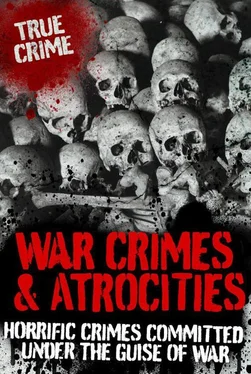The systematic persecution of the Jews and others deemed racially undesirable began with a series of laws requiring Jews to register their names, and passing laws that limited their business interests and social lives. Segregation then continued by herding the Jews into ghettoes in Europe’s large cities, where many died of disease and starvation, or were weakened to the point that they became permanently sick. Next, the victims were sent to so-called labour camps, which were in reality death camps. Herded into freight trains without sanitation or food, many bound for the camps died on the way, particularly children and the elderly. Once at the camps, the ‘Final Solution of the Jewish Question’ became a nightmare reality as the victims, many of whom had no idea what was in store for them, were herded into gas chambers. Those who were left in the camps often died from torture, neglect and starvation. The Nazi guards and their civilian supporters behaved, on the whole, with no mercy: even young children were subjected to the most horrifying ordeals.
CRIMES AGAINST HUMANITY
Despite the fact that the treatment of the Jews in Germany and across Europe was more barbaric than anyone could possibly have imagined, the Third Reich operated an efficient bureaucracy that gave an air of supposed legitimacy to the murders. This was perhaps the most sinister aspect of the regime: that ordinary people were easily persuaded to take part in the most appalling crimes against humanity, simply because they were ordered to do so by the government.
After the war, chilling evidence came to light of the methodical way in which the Nazis had catalogued their horrific crimes. For example, the victims’ belongings were carefully listed, and the victims given receipts, possibly to stop them realizing what was going to happen to them. It was this semblance of officialdom that caused many Jews and minority groups to trust their captors, not understanding that they were bound for wholesale slaughter until it was too late.
BODY DISPOSAL
Exterminating human beings on the scale that the Nazis envisaged required new technologies, and accordingly, German scientists, industrialists and others worked hard to find efficient killing machines for their victims. Often, the Nazis used mental patients from asylums as guinea pigs, trying out various methods, such as mass shootings, explosives and machine gunning. They found that the most successful method to use was poisoned gas, such as carbon monoxide or Zyklon B, which took less than ten minutes to kill large numbers of people and was an easy way to dispose of hundreds of prisoners at a time.
The next problem was how to dispose of the hundreds of bodies after the gas had done its work. At this point, German industrialists stepped in, eager to lend a hand. Furnaces were developed that operated at high temperatures, and burned using human body fat, making the disposal of thousands of bodies relatively easy.
HUMAN EXPERIMENTS
With these technical solutions in place, the Germans and the 35 other European nations that collaborated with them set about the mass extermination of the Jews and other ‘undesirables’. However, for some unfortunate victims, the prospects were even worse than death in the gas chambers: the Nazis also carried out experiments on prisoners, including children and babies, under the pretext of advancing medical science, but in reality to feed their taste for sadism. For example, the notorious Dr Josef Mengele, under the guise of research into genetics, carried out horrific experiments on twins, dwarves and gypsies. Unbelievably, in one case he tried to sew two twins together to see what would happen. Another of his specialities was to inject dye into victims’ eyes to see how they would change colour; he also performed amputations and subjected his victims to drug tests and various methods of dying, including freezing. Few of his experiments were of any medical interest, and afterwards, the hapless victims were almost always put to death.
As well as these experiments, there were cruel investigations with the supposed aim of protecting German soldiers. For example, many Russian prisoners were used in experiments, such as being frozen to death in iced water, or subjected to intense air pressure, ostensibly to see how soldiers would fare in a war situation. In other cases, prisoners faced the naked brutality of the Nazi guards for no reason other than to satisfy their captors’ lust for violence; some were hung up on poles, others beaten to death.
CHILD LABOUR
The thousands of children taken to the concentration camps came in for the most terrible treatment, often being separated from their parents and taken straight to the gas chambers on arrival. Those who did not perish immediately were forced to work as slave labourers in factories and quarries, often ending the day by standing for hours waiting for their names to be read out in a roll call. Badly fed, with no proper medical care or sanitation, many children who lived and worked in the appalling conditions of the camps died before the end of the war.
DEATH MARCHES
Towards the end of the war, as the Allies were advancing through Europe, the Nazis began to move prisoners out of the death camps in an effort to destroy the evidence of what they had done. Inmates were marched miles through the snow to train stations, transported and then marched to their new camps. Many of the prisoners, who had suffered years of malnutrition and ill treatment, died during the ‘death marches’, as they became called – in total, around a 100,000. And this was not the end of the story. As Soviet and Allied forces began to discover the horrific truth of what had happened at the Nazis’ concentration camps, thousands of inmates were liberated. However, many of the prisoners were so weak by that time that they died within a few weeks of being set free.
The genocide at the hands of the Nazis and their collaborators was so extensive during World War II that, after the conflict was over, new legislation had to be enacted to encompass the crimes. The charge of ‘a crime against humanity’, which had been brought in after World War I, was now extended to cover all crimes against humanity and civilization by the Axis powers committed during the war (significantly, any crimes committed by the Allied powers were exempt from this). These crimes included murder, extermination, enslavement, deportation and other inhuman acts committed against civilian populations ‘whether or not in violation of the domestic law of the country where perpetrated’. What this meant in effect was that German ministers, officials, military officers and civilians could be charged in an international court of law for crimes committed during World War II, even if they were abiding by the rules of the Third Reich and its collaborators. This was because the crimes – whether committed by high-ranking officials, lowly guards or simply members of the public – went beyond the terms of the Geneva Convention, and constituted crimes, on a grand scale, against the whole of humanity.
Had the Allies failed to defeat the Axis powers, there is no doubt that the Nazis would have continued to carry out their programme of genocide in Britain and elsewhere. As it was, their avowed aim to exterminate all Jews in Europe in the ‘final solution to the Jewish question’ failed: but not before millions had been put to death in the most horrifying war crime of the 20th century, if not in the whole of human history.
Action T4 ‘Euthanasia Programme’
1939–41

One of the most horrifying aspects of the Nazi regime in Germany was the killing of up to 100,000 individuals with mental or physical disabilities. Under a programme known as ‘Action T4’, named after the address of the house where the headquarters of the operation was located (Tiergart enstrasse 4 in Berlin), Hitler ordered the killing of those identified as mentally or physically ‘diseased’, so as to cleanse the German people of ‘racial impurities’. Along with Jews, communists, homosexuals and other minority groups, those with any genetic defects, impairments or peculiarities were seen as undesirable elements to be got rid of, that is, put to death.
Читать дальше













